(完整版)初二英语语法不定式详解及习题
- 格式:doc
- 大小:44.02 KB
- 文档页数:4
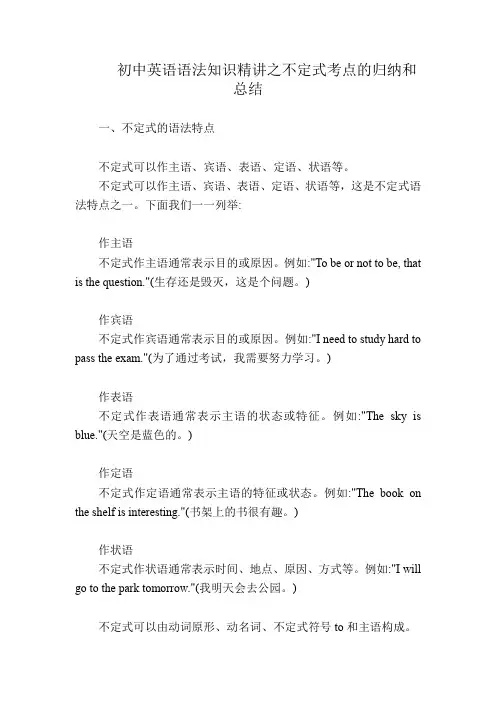
初中英语语法知识精讲之不定式考点的归纳和总结一、不定式的语法特点不定式可以作主语、宾语、表语、定语、状语等。
不定式可以作主语、宾语、表语、定语、状语等,这是不定式语法特点之一。
下面我们一一列举:作主语不定式作主语通常表示目的或原因。
例如:"To be or not to be, that is the question."(生存还是毁灭,这是个问题。
)作宾语不定式作宾语通常表示目的或原因。
例如:"I need to study hard to pass the exam."(为了通过考试,我需要努力学习。
)作表语不定式作表语通常表示主语的状态或特征。
例如:"The sky is blue."(天空是蓝色的。
)作定语不定式作定语通常表示主语的特征或状态。
例如:"The book on the shelf is interesting."(书架上的书很有趣。
)作状语不定式作状语通常表示时间、地点、原因、方式等。
例如:"I will go to the park tomorrow."(我明天会去公园。
)不定式可以由动词原形、动名词、不定式符号to和主语构成。
不定式可以由动词原形、动名词、不定式符号to和主语构成,这是不定式语法特点之一。
下面我们一一列举:动词原形不定式可以由动词原形构成,例如:"I want to eat pizza."(我想吃披萨。
)动名词不定式也可以由动名词构成,例如:"She enjoys playing soccer."(她喜欢踢足球。
)不定式符号to不定式还可以由不定式符号to和主语构成,例如:"To be or not to be, that is the question."(生存还是毁灭,这是个问题。
)主语不定式还可以由主语构成,例如:"The teacher gave the students a task to complete."(老师给学生布置了一个任务完成。
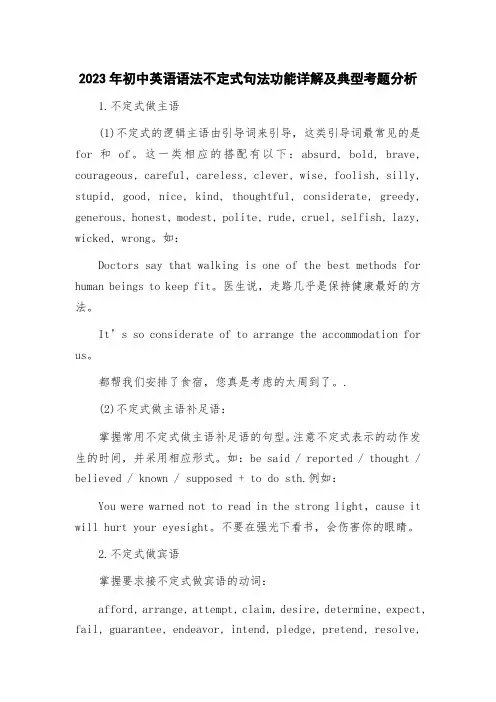
2023年初中英语语法不定式句法功能详解及典型考题分析1.不定式做主语(1)不定式的逻辑主语由引导词来引导,这类引导词最常见的是for 和of。
这一类相应的搭配有以下:absurd, bold, brave, courageous, careful, careless, clever, wise, foolish, silly, stupid, good, nice, kind, thoughtful, considerate, greedy, generous, honest, modest, polite, rude, cruel, selfish, lazy, wicked, wrong。
如:Doctors say that walking is one of the best methods for human beings to keep fit。
医生说,走路几乎是保持健康最好的方法。
It’s so considerate of to arrange the accommodation for us。
都帮我们安排了食宿,您真是考虑的太周到了。
.(2)不定式做主语补足语:掌握常用不定式做主语补足语的句型。
注意不定式表示的动作发生的时间,并采用相应形式。
如:be said / reported / thought / believed / known / supposed + to do sth.例如:You were warned not to read in the strong light,cause it will hurt your eyesight。
不要在强光下看书,会伤害你的眼睛。
2.不定式做宾语掌握要求接不定式做宾语的动词:afford, arrange, attempt, claim, desire, determine, expect, fail, guarantee, endeavor, intend, pledge, pretend, resolve,request, swear, tend, venture。

Module 7 Summer in Los Angeles一.重点单词和短语二.语法回顾:并列句并列句是由并列连词把两个或两个以上平等而又互相独立的分句(简单句)连接而成的句子。
并列句中的分句均读降调。
并列句的句式为:简单句+并列连词+简单句。
使用不同的并列连词可以表示出并列句中各分句之间的不同关系。
(1)并列关系常用的表示并列关系的连词有and,nor等。
eg:I help her and she helps me. 我帮她,她帮我。
He does not do it,nor does he try. 他没有做,也没有尝试一下。
(2)转折关系常用的转折连词有but,yet等。
eg:He is very old but he is in good health. 他年纪很大了,但身体很好。
It is very good,yet it can be better. 这很好,但还能精益求精。
(3)选择关系常用的表示选择关系的连词有or,either…or等。
eg:He wants to go swimming or (he wants to) go shopping. 他想去游泳或是购物。
Either you are wrong or I am. 不是你错了,就是我错了。
(4)因果关系常用的表示因果关系的连词有for,so等。
eg:The days were short,for it was December now. 白天短了,因为现在是12月了。
The girl did her work carefully,so she never made any mistakes.这个女孩工作认真,因此从不出差错。
三.语法操练一、单项选择。
1.—Which do you prefer,tea ________coffee? —Tea,please.A.but B.so C.or D.and2.—Would you like to come to my party on Saturday,Sam?—I'd love to,________I can't. I have to take a piano lesson.A.and B.but C.or D.so3.Be quick,________we'll be late for the meeting.A.and B.but C.so D.Or4.I thought the actor was famous,________none of my friends has ever heard of him. A.and B.or C.so D.but5.Work hard,______you will succeed.A.or B.so C.and D.But6.—Sam,what can I do to get up early? —Set the alarm at 6∶00 am,________you'll make it. A.or B.but C.and D.so7.________Bill ________Tom will go to your party,because one of them must stay at home to look after the baby.A.Neither;nor B.Either;or C.Both;and D.Either;nor 8.—I don't like singing ________dancing. What about you?—I don't like dancing,________ I like singing.A.and;and B.and;but C.or;but D.or;and 9.Stop smoking,________you'll get better soon.A.or B.but C.so D.and10.There are no buses,________you'll have to walk.A.so B.or C.but D.for11.Hurry up,________finish your homework!A.or B.but C.and D.while12.Ben was busy taking a training class,______we had to wait for him for half an hour. A.so B.if C.or D.but答案:1-5 CBDDC 6-10 CBCDA 11-12 CA二、根据句意从方框中选择正确的并列连词填空。
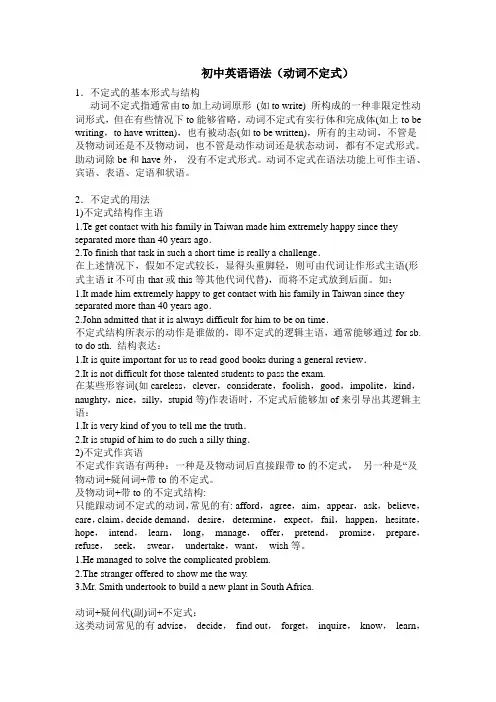
初中英语语法(动词不定式)1.不定式的基本形式与结构动词不定式指通常由to加上动词原形(如to write) 所构成的一种非限定性动词形式,但在有些情况下to能够省略。
动词不定式有实行体和完成体(如上to be writing,to have written),也有被动态(如to be written),所有的主动词,不管是及物动词还是不及物动词,也不管是动作动词还是状态动词,都有不定式形式。
助动词除be和have外,没有不定式形式。
动词不定式在语法功能上可作主语、宾语、表语、定语和状语。
2.不定式的用法1)不定式结构作主语1.Te get contact with his family in Taiwan made him extremely happy since they separated more than 40 years ago.2.To finish that task in such a short time is really a challenge.在上述情况下,假如不定式较长,显得头重脚轻,则可由代词让作形式主语(形式主语it不可由that或this等其他代词代替),而将不定式放到后面。
如:1.It made him extremely happy to get contact with his family in Taiwan since they separated more than 40 years ago.2.John admitted that it is always difficult for him to be on time.不定式结构所表示的动作是谁做的,即不定式的逻辑主语,通常能够通过for sb. to do sth. 结构表达:1.It is quite important for us to read good books during a general review.2.It is not difficult fot those talented students to pass the exam.在某些形容词(如careless,clever,considerate,foolish,good,impolite,kind,naughty,nice,silly,stupid等)作表语时,不定式后能够加of来引导出其逻辑主语:1.It is very kind of you to tell me the truth.2.It is stupid of him to do such a silly thing.2)不定式作宾语不定式作宾语有两种:一种是及物动词后直接跟带to的不定式,另一种是“及物动词+疑问词+带to的不定式。
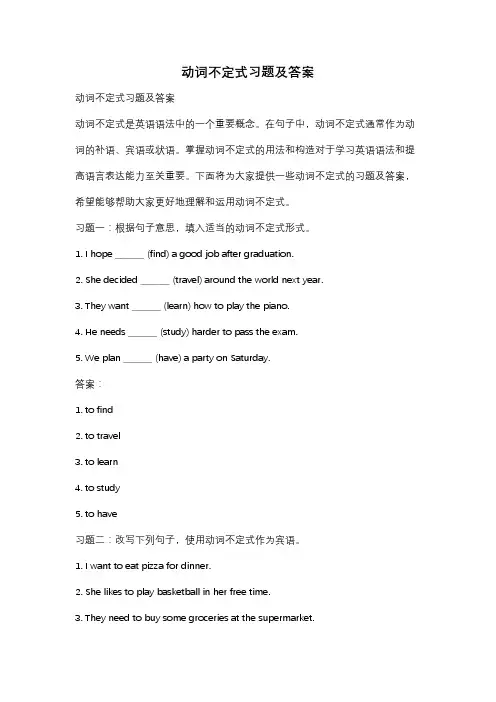
动词不定式习题及答案动词不定式习题及答案动词不定式是英语语法中的一个重要概念。
在句子中,动词不定式通常作为动词的补语、宾语或状语。
掌握动词不定式的用法和构造对于学习英语语法和提高语言表达能力至关重要。
下面将为大家提供一些动词不定式的习题及答案,希望能够帮助大家更好地理解和运用动词不定式。
习题一:根据句子意思,填入适当的动词不定式形式。
1. I hope _______ (find) a good job after graduation.2. She decided _______ (travel) around the world next year.3. They want _______ (learn) how to play the piano.4. He needs _______ (study) harder to pass the exam.5. We plan _______ (have) a party on Saturday.答案:1. to find2. to travel3. to learn4. to study5. to have习题二:改写下列句子,使用动词不定式作为宾语。
1. I want to eat pizza for dinner.2. She likes to play basketball in her free time.3. They need to buy some groceries at the supermarket.4. He loves to watch movies on weekends.5. We enjoy swimming in the ocean during summer vacation.答案:1. I want to have pizza for dinner.2. She likes playing basketball in her free time.3. They need to go to the supermarket to buy some groceries.4. He loves watching movies on weekends.5. We enjoy swimming in the ocean during summer vacation.习题三:根据句子意思,选择适当的动词不定式形式。
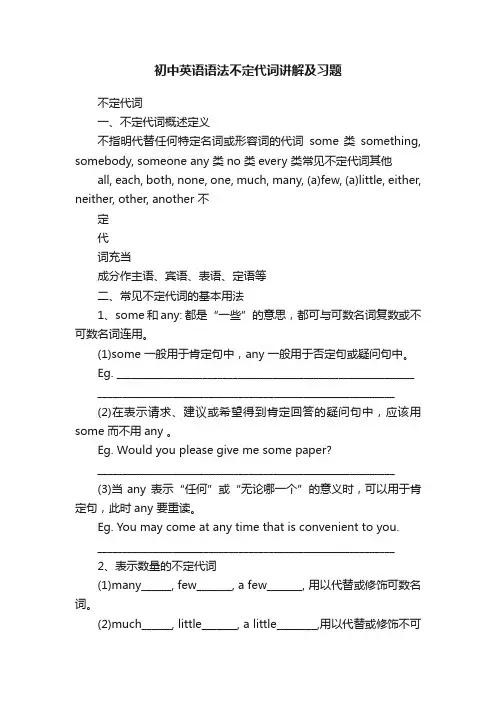
初中英语语法不定代词讲解及习题不定代词一、不定代词概述定义不指明代替任何特定名词或形容词的代词some 类something, somebody, someone any 类no 类every 类常见不定代词其他all, each, both, none, one, much, many, (a)few, (a)little, either, neither, other, another 不定代词充当成分作主语、宾语、表语、定语等二、常见不定代词的基本用法1、some 和any: 都是“一些”的意思,都可与可数名词复数或不可数名词连用。
(1)some 一般用于肯定句中,any 一般用于否定句或疑问句中。
Eg. ___________________________________________________________ ___________________________________________________________(2)在表示请求、建议或希望得到肯定回答的疑问句中,应该用some 而不用any 。
Eg. Would you please give me some paper?___________________________________________________________(3)当any 表示“任何”或“无论哪一个”的意义时,可以用于肯定句,此时any 要重读。
Eg. You may come at any time that is convenient to you.___________________________________________________________2、表示数量的不定代词(1)many______, few_______, a few_______, 用以代替或修饰可数名词。
(2)much______, little_______, a little________,用以代替或修饰不可数名词。
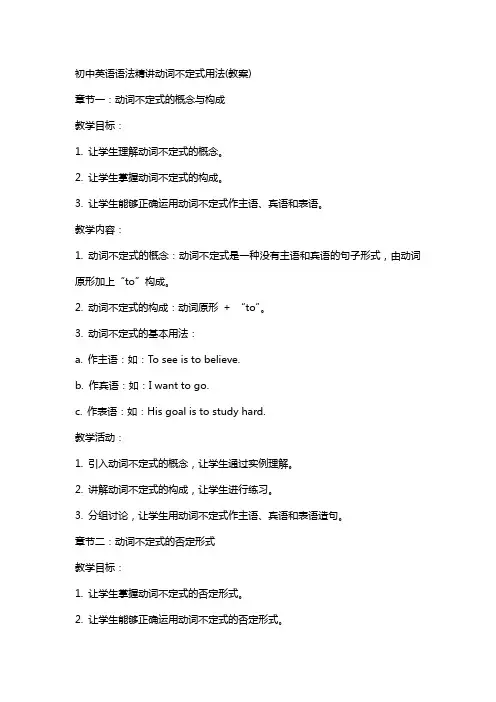
初中英语语法精讲动词不定式用法(教案)章节一:动词不定式的概念与构成教学目标:1. 让学生理解动词不定式的概念。
2. 让学生掌握动词不定式的构成。
3. 让学生能够正确运用动词不定式作主语、宾语和表语。
教学内容:1. 动词不定式的概念:动词不定式是一种没有主语和宾语的句子形式,由动词原形加上“to”构成。
2. 动词不定式的构成:动词原形+ “to”。
3. 动词不定式的基本用法:a. 作主语:如:To see is to believe.b. 作宾语:如:I want to go.c. 作表语:如:His goal is to study hard.教学活动:1. 引入动词不定式的概念,让学生通过实例理解。
2. 讲解动词不定式的构成,让学生进行练习。
3. 分组讨论,让学生用动词不定式作主语、宾语和表语造句。
章节二:动词不定式的否定形式教学目标:1. 让学生掌握动词不定式的否定形式。
2. 让学生能够正确运用动词不定式的否定形式。
1. 动词不定式的否定形式:在“to”前面加上“not”,即“not to”。
2. 动词不定式的否定形式的用法:表示否定意义,如:I don't want to go.教学活动:1. 讲解动词不定式的否定形式,让学生进行练习。
2. 小组活动,让学生用动词不定式的否定形式造句。
章节三:动词不定式的疑问形式教学目标:1. 让学生掌握动词不定式的疑问形式。
2. 让学生能够正确运用动词不定式的疑问形式。
教学内容:1. 动词不定式的疑问形式:在“to”前面加上“do/does/did”,如:Do you want to go?2. 动词不定式的疑问形式的用法:用于提问,如:Do you want to go shopping?教学活动:1. 讲解动词不定式的疑问形式,让学生进行练习。
2. 小组活动,让学生用动词不定式的疑问形式提问。
章节四:动词不定式作主语教学目标:1. 让学生掌握动词不定式作主语的用法。
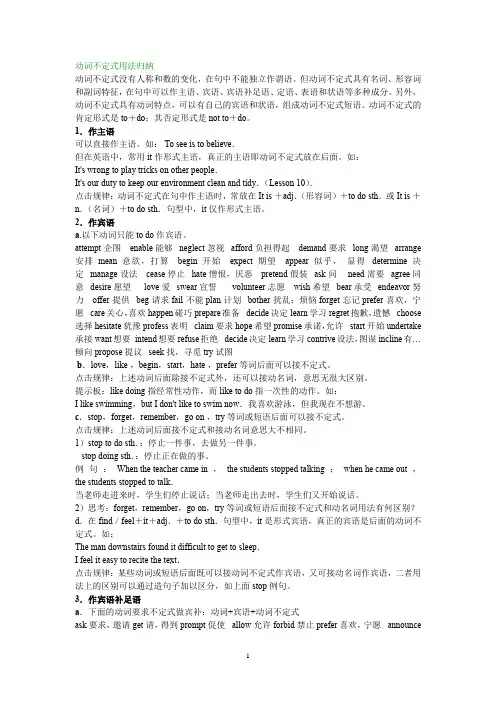
动词不定式用法归纳动词不定式没有人称和数的变化,在句中不能独立作谓语。
但动词不定式具有名词、形容词和副词特征,在句中可以作主语、宾语、宾语补足语、定语、表语和状语等多种成分。
另外,动词不定式具有动词特点,可以有自己的宾语和状语,组成动词不定式短语。
动词不定式的肯定形式是to+do;其否定形式是not to+do。
1.作主语可以直接作主语。
如:To see is to believe.但在英语中,常用it作形式主语,真正的主语即动词不定式放在后面。
如:It's wrong to play tricks on other people.It's our duty to keep our environment clean and tidy.(Lesson10).点击规律:动词不定式在句中作主语时,常放在It is+adj.(形容词)+to do sth.或It is+n.(名词)+to do sth.句型中,it仅作形式主语。
2.作宾语a.以下动词只能to do作宾语。
attempt企图enable能够neglect忽视afford负担得起demand要求long渴望arrange 安排mean意欲,打算begin开始expect期望appear似乎,显得determine决定manage设法cease停止hate憎恨,厌恶pretend假装ask问need需要agree同意desire愿望love爱swear宣誓volunteer志愿wish希望bear承受endeavor努力offer提供beg请求fail不能plan计划bother扰乱;烦恼forget忘记prefer喜欢,宁愿care关心,喜欢happen碰巧prepare准备decide决定learn学习regret抱歉,遗憾choose 选择hesitate犹豫profess表明claim要求hope希望promise承诺,允许start开始undertake 承接want想要intend想要refuse拒绝decide决定learn学习contrive设法,图谋incline有…倾向propose提议seek找,寻觅try试图b.love,like,begin,start,hate,prefer等词后面可以接不定式。
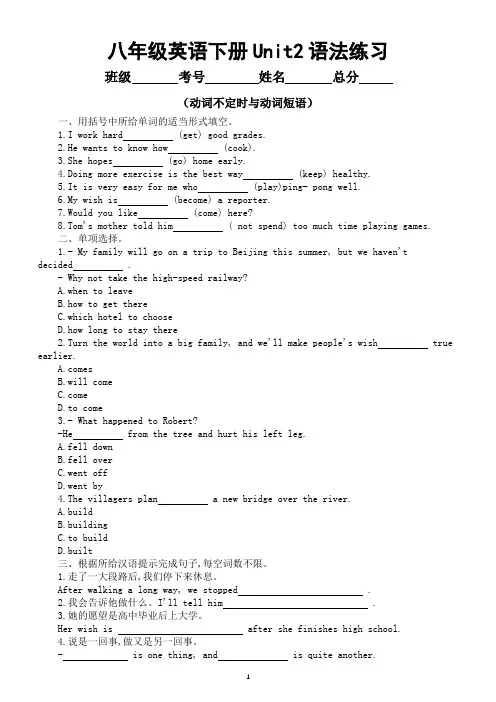
八年级英语下册Unit2语法练习班级考号姓名总分(动词不定时与动词短语)一、用括号中所给单词的适当形式填空。
1.I work hard (get) good grades.2.He wants to know how (cook).3.She hopes (go) home early.4.Doing more exercise is the best way (keep) healthy.5.It is very easy for me who (play)ping- pong well.6.My wish is (become) a reporter.7.Would you like (come) here?8.Tom's mother told him ( not spend) too much time playing games.二、单项选择。
1.- My family will go on a trip to Beijing this summer, but we haven'tdecided .- Why not take the high-speed railway?A.when to leaveB.how to get thereC.which hotel to chooseD.how long to stay there2.Turn the world into a big family, and we'll make people's wish true earlier.esB.will comeeD.to come3.- What happened to Robert?-He from the tree and hurt his left leg.A.fell downB.fell overC.went offD.went by4.The villagers plan a new bridge over the river.A.buildB.buildingC.to buildD.built三、根据所给汉语提示完成句子,每空词数不限。
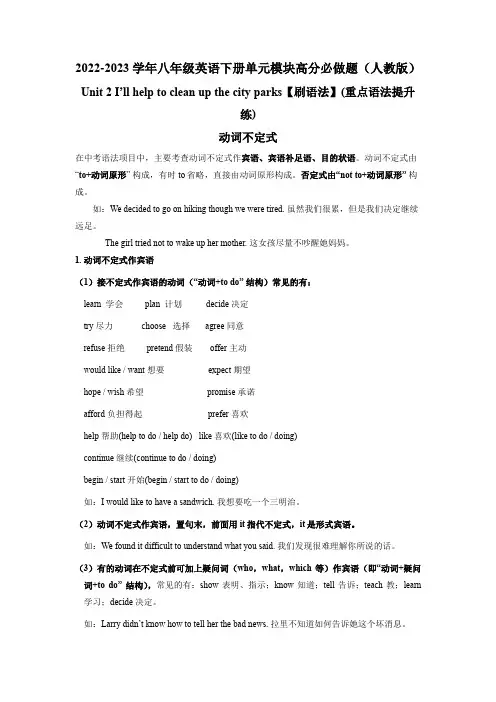
2022-2023学年八年级英语下册单元模块高分必做题(人教版)Unit 2 I’ll help to clean up the city parks【刷语法】(重点语法提升练)动词不定式在中考语法项目中,主要考查动词不定式作宾语、宾语补足语、目的状语。
动词不定式由“to+动词原形” 构成,有时to省略,直接由动词原形构成。
否定式由“not to+动词原形”构成。
如:We decided to go on hiking though we were tired. 虽然我们很累,但是我们决定继续远足。
The girl tried not to wake up her mother. 这女孩尽量不吵醒她妈妈。
1. 动词不定式作宾语(1)接不定式作宾语的动词(“动词+to do” 结构)常见的有:learn 学会 plan 计划 decide 决定try 尽力 choose 选择 agree 同意refuse 拒绝 pretend 假装 offer 主动would like / want 想要 expect 期望hope / wish 希望 promise 承诺afford 负担得起 prefer 喜欢help 帮助(help to do / help do) like 喜欢(like to do / doing)continue 继续(continue to do / doing)begin / start 开始(begin / start to do / doing)如:I would like to have a sandwich. 我想要吃一个三明治。
(2)动词不定式作宾语,置句末,前面用it指代不定式,it是形式宾语。
如:We found it difficult to understand what you said. 我们发现很难理解你所说的话。
(3)有的动词在不定式前可加上疑问词(who,what,which等)作宾语(即“动词+疑问词+to do” 结构),常见的有:show 表明、指示;know 知道;tell 告诉;teach 教;learn 学习;decide 决定。
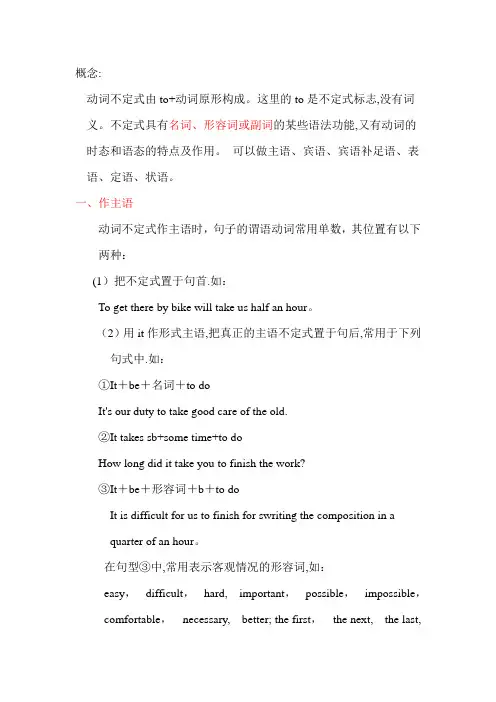
概念:动词不定式由to+动词原形构成。
这里的to是不定式标志,没有词义。
不定式具有名词、形容词或副词的某些语法功能,又有动词的时态和语态的特点及作用。
可以做主语、宾语、宾语补足语、表语、定语、状语。
一、作主语动词不定式作主语时,句子的谓语动词常用单数,其位置有以下两种:(1)把不定式置于句首.如:To get there by bike will take us half an hour。
(2)用it作形式主语,把真正的主语不定式置于句后,常用于下列句式中.如:①It+be+名词+to doIt's our duty to take good care of the old.②It takes sb+some time+to doHow long did it take you to finish the work?③It+be+形容词+b+to doIt is difficult for us to finish for swriting the composition in aquarter of an hour。
在句型③中,常用表示客观情况的形容词,如:easy,difficult,hard,important,possible,impossible,comfortable,necessary,better; the first,the next,the last,the best,too much,too little,not enough④It+be+形容词+of sb+to doIt is stupid of you to write down everything the teacher says.在句型④中,常用careless,clever,good,foolish,honest,kind,lazy,nice,right,silly,stupid,wise rude,clever,foolish,thoughtful, thoughtless(欠考虑的;不考虑的),brave,considerate(考虑周到的),selfish(自私的)等表示赞扬或批评的词。
初二上册英语语法总结动词不定式一. 定义:动词不定式是非谓语动词的一种,它没有人称和数的变化,在句子中不能独立作谓语,但它仍保持动词的特点,既可以有自己的宾语和状语。
同时动词不定式又具有名词、形容词、副词的特征,在句中可以作主语、表语、宾语、宾语补足语、定语和状语。
二. 动词不定式的构成:to+动词原形三. 动词不定式作宾语后面能接不定式作宾语的动词有:agree, ask, choose, decide, forget, hope, learn, want, wish, would like等。
We hope to get there before dark. 我们希望天黑以前到那儿。
The girl decided to do it herself. 那个姑娘决定自己做那件事。
动词不定式作宾语的注意事项(2点)1. 有些动词既可跟不定式作宾语,也可跟动名词作宾语,但含义不同:remember to do 记住要做某事remember doing 记得曾经做过某事forget to do忘记要做某事forget doing 忘记曾经做过某事stop to do 停下来去做某事stop doing 停止做某事go on to do 继续做另一件事go on doing 继续做原来在做的事I remember seeing you somewhere before.我记得以前在哪儿见过你。
Please remember to turn off the light when you leave.离开时请记得关好灯。
2. 不定式作宾语时,如带有宾语补足语,则要把不定式放到后面,用it作形式宾语,构成“主语+动词+it+宾补(形容词、名词)+不定式”结构。
如:He found it very difficult to get to sleep.他发现很难入睡。
四. 动词不定式作宾语补足语1. 后面能接to不定式作宾语补足语的动词有:ask, order, teach, tell, want, wish, help等。
初中英语语法不定式解析初中英语语法不定式解析不定式的构成非常简单,to+动词原形。
当然啦,to有时可以以不带。
动词不定式没有人称和数的变化,能够担当除谓语外的任何句子成分。
那什么时候能够不带to呢?下面是我给大家带来的初中英语语法不定式解析,希望能够帮助到大家!初中英语语法不定式解析不定式省to有四种情况:使役动词let,have,make等后接不定式。
如:Lethimgo!让他走!wouldrather,hadbetter后。
如:Youhadbetterstayathome.你最好呆在家里。
Why.../whynot...后。
如:WhynothaveagoodrestonSunday?为什么星期天不好好休息一下呢?感官动词see,watch,lookat,hear,listento,smell,feel,find等后作宾补,省to。
如:Isawhimdance.我看见他跳舞。
注意:这些情况在被动句中可千万不可省to哟!如:Thebossmadethemworkthewholenight.变成被动句:Theyweremadetoworkthewholenight.不定式的特殊用法:It与不定式:动词不定式能够做主语,但假如动词不定式太长,显得头重脚轻的,那么我们就可用形式主语it代替,而把真正主语(即不定式)放于句尾。
如:ItisnotdifficultformetostudyEnglishwell.(对我来讲学好英语是可能的。
)不定式还能够充当句子的宾语,但有些动词,如find,think,believe等,在语法上不能接受不定式作宾语,只要用it作形式宾语,进而把动词不定式置于句尾。
这样的不定式可继续充当其宾语的作用。
如:Ifounditdifficulttofallasleep.我发现很难入睡。
还有一点:动词不定式,还可用在how,when,where,what,which等疑问代词或副词之后,与其共同作宾语。
英语语法详解——不定式的用法不定式一、概说不定式是一种非限定动词,通常由"to+动词原形"构成,如to be,to do,to combine,to expand,to get up等。
这里的to是不定式的符号,没有词义,有时还可以省略。
动词不定式没有人称和数的变化。
不定式在句中不能单独用作谓语,但还保留着动词的若干特征:可以带状语,及物动词可以带宾语,系动词可以带表语。
不定式可以连同它的附属成分一起组成不定式短语。
例如:We decided to begin the experiment in the afternoon.【在不定式短语to begin the experiment in the afternoon中,the experiment 是begin的宾语,in the afternoon是状语。
整个不定式短语在句中作谓语动词decided的宾语。
】我们决定了下午开始做实验。
二、不定式的用法不定式(短语)在句中起相当于名词、形容词或副词的作用,可作主语、表语、宾语、定语、状语和宾语补语。
(一)具有名词的性质1.用作主语。
例如:(1)To make you understand him completely is impossible.让你们完全了解他是不可能的。
(2)To run machines needs power.开动机器需要动力。
(3)To remember to switch off the electricity is important.重要的是要记住关掉电源。
To live is to function.That is all there is in living.(Holmes)活着就要发挥作用,这就是生活的全部真谛。
To live of money is the root of all evil.(R.L.Stevenson)迷恋金钱是一切罪恶的根源。
八年级下册Unit2 语法练习题---动词不定式( ) 1. It often takes me half an hour home.A. walkingB. to walkC. walkedD. walk( ) 2. Don’t forget her clean water every day.A. to giveB. givingC. givenD. give( ) 3. I think it important English well.A. learningB. learnC. to learnD. learned( ) 4. The funny story makes us .A. laughB. laughingC. to laughD. laughed( ) 5. She was often heard in English.A. singB. singingC. sungD. to sing( ) 6. Our teacher told us hard.A. to workB. workingC. workedD. work( ) 7. Could you tell me this word?A. to how readB. how to readC. how readD. how read to( ) 8. I don’t know .A. when startB. when to startC. to how startD. how start( ) 9. Please give me a pen .A. to writeB. writingC. to write withD. written( ) 10. He went home some books.A. gotB. gettingC. getD. to get( ) 11. Remember late for class again.A. not toB. not to beC. to be notD. be not to( ) 12. Miss Li likes the students questions.A. askB. askingC. to askD. asked( ) 13. Would you please ?A. not to go thereB. to go thereC. not go thereD. going there( ) 14. You don’t look well. Why to see the doctor?A. not to goB. you not to goC. not goD. didn’t go ( ) 15. Let’s to the cinema together.A. to goB. goingC. goD. went( ) 16. Jim asked Li Ping his best wishes to everybody.A. giveB. gaveC. givingD. to give( ) 17. Please tell him the light when he leaves.A. to turn offB. turn downC. turn offD. to turn down ( ) 18. I’m sorry your friend is ill.A. hearB. to hearC. listenD. to listen( ) 19. You had better home at once. Don’t keep your mother .A. to, waitB. going, waitingC. to go, to waitD. go, waiting( ) 20. Will you please get me something ?A. to eatB. eatC. eatingD. for eating( ) 21. I’d like a word with you.A. hadB. havingC. to haveD. have( ) 22. Hurry up! It’s time .A. for have classB. having classC. have classD. to have class( ) 23. I have something important you.A. tellB. tellingC. to tellD. tell to( ) 24. It’s important and helpful.A. to be kindB. to kindC. be kindD. kind( ) 25. The young man is old enough the army.A. joinB. joiningC. to joinD. joins( ) 26. His wish was a scientist.A. to becomesB. becomesC. becomeD. to become ( ) 27. The teacher agreed lessons to his students.A. giveB. that he giveC. to giveD. that he will give ( ) 28. All the students learned up words in a dictionary.A. look howB. how to lookC. how lookD. to how look ( ) 29. Nobody knew a living in that country.A. go toB. to makeC. how to goD. how to make ( ) 30. The baby started . Try it quiet.A. cry, keepB. to cry, to keepC. to cry, keepD. cry, to keep( ) 31. He hopes better, but never works hard.A. how to studyB. to how studyC. to study howD. to study( ) 32. I never heard him so.A. sayB. to sayC. sayingD. having said( ) 33. The teacher made her students text twice a day.A. recite theB. recitingC. to recite theD. recited the ( ) 34. She was seen paper planes in the room.A. madeB. to makeC. makesD. making( ) 35. We sometimes heard songs in English.A. that he singB. that he singsC. him to singD. him sing( ) 36. I won’t have him at his mother.A. shoutB. to shoutC. shoutingD. to have shouted ( ) 37. He made us on the tree.A. go, to waterB. to go, to waterC. go, wateringD. to go, water( ) 38. We have no money and no place .A. to live inB. to liveC. living inD. living( ) 39. I have a few words to you.A. sayB. to sayC. speakD. to speak( ) 40. There is no chair for me .A. to sit atB. sit withC. to sitD. to sit in( ) 41. Do you have anything for yourself?A. tellB. sayC. to tellD. to say( ) 42. Here is the pen I want .A. to write withB. to writeC. writingD. to writing ( ) 43. He is always the first and the last .A. coming, leavingB. to come, to leaveC. comes, leavesD. come, leave( ) 44. I don’t feel some cooking.A. enough well to doB. well enough to doC. enough well and doD. well enough and do( ) 45. Do you think him easy ?A. to get along withB. to get alongC. to be got along withD. to be got along( ) 46. The man run out what was wrong with his horse.A. to seeB. seeingC. seeD. for seeing( ) 47. The book is difficult .A. to be readB. to readC. read underD. to read by ( ) 48. Remember the book in time when you have finished it.A. to return, readingB. returning, readingC. returning, to readD. to return, to read( ) 49. Do you often see her for him at the bus stop?A. waitB. to waitC. waitingD. being waited( ) 50. Mother warns him any more.A. to not smokeB. not to smokeC. not smokingD. don’t smoke( ) 51. The patient refused any medicine.A. haveB. to haveC. how to haveD. to how have ( ) 52. Lucy ran home the money.A. to getB. gettingC. getD. for getting( ) 53. The teacher explained to them the piano.A. that they playedB. how they playC. to playD. how to play( ) 54. It’s foolish her to over a film.A. for, cryB. of, cryingC. for, cryingD. of, cry( ) 55. Do you understand the machine.A. how to operateB. to how operateC. to operateD. that you operate( ) 56. Did you notice the little boy away?A. took the apple and runB. take the apples and runC. taking the apple and runD. who taking the apple and run( ) 57. I think the boy is reach the apple.A. enough tall toB. tall enough toC. short enoughD. enough short to( ) 58. Many people like to watch others the game.A. playsB. playedC. to playD. play( ) 59. The doctor advised Lao Li more rest.A. that he getB. to getC. would getD. get( ) 60. Our teacher told us waste time.A. notB. not toC. don'tD. to not( ) 61. Would you please a rest? You looked tired.A. to stop haveB. to stop to haveC. stop havingD. stop to have( ) 62. It’ll take me only twenty minutes school.A. walkB. walkingC. to walkD. walked( ) 63. He has something about with them.A. to talkB. talkC. to tellD. tell( ) 64. We have no time a rest.A. haveB. takeC. takingD. to have( ) 65. I have three more letters today.A. I writeB. to writeC. to write toD. writing( ) 66. This is the room .A. for me to liveB. for me livingC. my living inD. for me to live in( ) 67. The students used bikes water for Granny Wang.A. to carryB. carryC. carryingD. carried( ) 68. Does he often you on Sunday?A. come to seeB. comes to seeC. comes and seesD. come and to see参考答案:1-5 BACAD 6-10ABBCD 11-15BCCCC 16-20DABDA21-25CDCAC 26-30DCBDB 31-35DAABD 36-40ACABD41-45DABBA 46-50ABAAB 51-55BADDA 56-60BBDBB61-65DCADB 66-68DAA。
目录1 不定式的语法功能 (3)2 不定式的几个主要句型及应注意事项 (12)习题 (22)答案 (23)什么是不定式呢?请看下面例句:例:I want to go.我想去。
在这个句子中有两个表示动作的动词:一个是want,另外一个是to go。
want是这个句子的主要动词,它会随着主语的人称、数和时态而变化,例如:He wants~(主语是第三人称,现在时);He wanted~(过去时)。
to go,不管主语的数、人称和时态如何变化,它永远保持《to+动词原形》的形式,to go就是不定式。
所以说,不定式中所谓“不定”是不受主语的数(单数或复数)和人称(第一人称、第二人称、第三人称)以及时态、语态等的影响或限定的意思。
例如:一般现在时:He wants to go.一般过去时:I wanted to go.一般过去时的被动语态:They were asked to go.在上述三句中,主语、时态、语态有变化,但不定式to go不受影响,毫无变化。
总结:动词不定式的基本形式是《to +动词原形》,有时可以不带to。
动词不定式没有人称和数的变化,在句子中不能作谓语。
(但可以担任除谓语外的任何成分——主语、表语、宾语、状语和宾语补足语。
)动词不定式仍保留动词的特点,即它可以有自己的宾语和状语。
动词不定式和它的宾语或状语构成不定式短语。
注意不定式前面的to(或称为小品词)和介词用的to是不同的。
介词to 后面要跟名词或代词的宾格,或相当于名词的词及短语做它的宾语。
而不定式的小品词to后面要跟动词原形。
listen to me(to是介词)to read the book(to是不定式的小品词)1 不定式的语法功能不定式《to +动词原形》在句子中有各种作用,一般可归类为三种基本用法,如下:1.作名词的用法2.作副词的用法3.作形容词的用法。
不定式的形式担当主语的词一般的句子都以名词(如Tom,the pen…)或代名词(如he,this…)作为主语。
初中英语语法之不定式相关考点难点分析不定式概述不定式概述1) 不定式的种类不定式有两种。
一种是带to的不定式(a),另一种是不带 to 的不定式(b)。
不带 to 的不定式和动词原形相同。
a) He wants to become a teacher. 他想成为一名教师。
b) I can help you remember that. 我可以帮助你记住那个。
2) 不定式的形式一般形式:to do完成式: to have done进行式: to be doing一般式的被动形式: to be done完成式的被动形式: to have been done完成进行式: to have been doing不定式的完成式* He seems to have caught a cold. 他好像感冒了。
* I happened to have come across the book once. 我碰巧有一次见过这本书。
* There was a lot of fun at yesterday's party.You ought to have come,but why didn't you? 昨天的聚会很好玩。
你应该来的,为什么没来呢?* It was a great satisfaction to have revisited our nativevillage. 重访了家乡是非常愉快的事。
* I hoped to have seen you yesterday,but I didn't have time.昨天我本来想去看你,但没有空。
* I regret to have been the cause of all this trouble. 我很抱歉引起了这么多麻烦。
* You are lucky to have got tickets to the concert. 你运气好弄到了音乐会的票。
初二英语语法:动词不定式详解及习题一..不定式的构成:to+ 动词原形二不定式的特征:不定式不能单独作谓语,没有人称和数的变化,动词不定式具有名词,形容词,和副词的特征,可以在句子中作主语,表语,宾语。
宾语补足语,定语,和状语。
现将用法归纳如下。
(一)、动词不定式作主语动词不定式作主语时,可以直接放在谓语动词前面的主语位置,也可以用先行词it作形式主语,而将真正的主语(不定式)置于后面。
常见的句式有:(1)It is +形容词(of sb)to do sth.(2)It is +名词(for sb)to do sth(3)It takes sb some time to do sth(4)It is +形容词(for sb)to do sth.句式注意:当不定式作主语的句子中又有一个不定式作表语时,不能用It is…to…的句型(对)To see is to believe.百闻不如一见。
(错)It is to believe to see.It's for sb.和It's of sb.1) for sb. 常用于表示事物的特征特点,表示客观形式的形容词,如easy, hard, difficult,interesting, impossible等:It's very hard for him to study two languages. 对他来说学两门外语是很难的。
2) of sb的句型一般用表示人物的性格,品德,表示主观感情或态度的形容词,如good, kind, nice, clever, foolish, right。
It's very nice of you to help me. 你来帮助我,你真是太好了。
(二)、动词不定式作宾语1. He wants to buy some vegetables.2. Don't forget to bringyour homework with you when you come to school.3. He found it very difficult ______.常接不定式作宾语的动词;want,like,agree,hope,wish,learn,begin,start,seem,decide,hate,choose,forget,remember等动词后面,可以接不定式作宾语。
如果其后接形容词补足语时,则可以用it作形式宾语,而把作真正宾语的不定式放到后面Sb + V + it (形式宾语)+ agj (形容词)+to+ V(宾语)注意无BE动词。
(三)、动词不定式作宾语补足语Mr Li often teaches his Japanese friends to cook Chinese food.He found it very difficult to learn English well.不定式可以用作宾语补足语。
后面可以接不定式作宾语补足语的动词有:ask,teach,expect,tell,allow 等。
如果其后接形容词补足语时,则可以用it作形式宾语,而把作真正宾语的不定式放到后面Sb + V + it (形式宾语)+ agj (形容词)+to+ V(宾语)注意无be动词。
(四)、动词不定式作状语.She went to visit her teacher.go,come,try,do / try one's best等动词或短语动词作谓语时,其后常常可以接不定式作目的状语。
be +形容词+ to do sth"结构中的不定式作状语,常表示原因或方式。
too +形容词/副词(for sb)to do…"(太……而不能……)和"enough (for sb) to do…"(足以、足够……做……)结构中,不定式作结果状语。
so\such......... that........如此......以致......的用法及与其它句型的互换.A.Sb\Sth +be\ V+ so + adj\adv (a\an+adj +n)+that + can't\couldn't.........= Sb\Sth +be\ V+ too+adj\adv(for+Sb\Sth)+to+V ...... .....如此......以致....=太而.....不能.....B、.so that to =in order to+V动词\that+从句......为了\以便于......C、.Sb\Sth +be+ so + adj形容词+a \an \+n \V +adv副词(so +little\many\much.... such +a\an+adj +n 名形容词+名词)+that + can\ould=.Sb\Sth +be\ V+adj\adv +enough足够的+ to+V.....如此.....以致于.....=......足够.......干..........如:他太年轻了而不能去上学。
A. He is too young to go to school.B. He is so young that he can’t go to schoolC.He is n’t old enough to go to school.D. He is so a young boy that he can’t go to school(五)、动词不定式作定语Would you like something to drink?不定式作定语时,常放在被修饰的词语之后,与被修饰的词语为逻辑上的主谓关系或动宾关系;如果不定式的动词是不及物动词,其后要加上必要的介词或副词,构成的短语动词相当于及物动词。
(六)、动词不定式作表语(体现形容词的特性)My dream is to be a teacher.注意:不带to的动词不定式在see,watch,hear,feel等感官动词和make,have,let等使役动词后面作宾语补足语的不定式不带to.但是在被动语态中,作主语补足语的不定式要带to(let没有被动语态)。
2.在"。
had better+V/not +V 最好干。
"后面接不带to的不定式。
四。
动词不定式的否定形式]动词不定式的否定形式通常是在不定式符号to的前面加上not,如果是不带to的不定式就直接在动词原形前面加上not.五、某些动词后面接不定式和接动词-ing形式的区别一些常见的动词后面接不定式和接动词的-ing形式的区别如下:"stop to do sth"意为"停止正在做的事情去做另外一件事","stop doing sth"意为"停止正在做的事":"remember to do sth"意为"记住去做某事"(事还未做),"remember doing sth"意为"记得做过某事"(事已做):"go on to do sth"意为"接着做某事"(做完一事,接着做另一事),"go on doing sth"意为"继续做某事"(一事未做完接着往下做):"forget to do sth"意为"忘了做某事"(事还未做),"forget doing sth"意为"忘了曾做过某事"(事已做)。
六、另外注意1)、带双宾语的及物动词,如:give …Sth.. to Sb ,.send….. to .bring….. to take….. to teach….. to want….. to.. lend…. to…,show ....to ...etc to可以作介词用+ 人/物/地点,大部分带双宾语的动词是接to +Sb(间接宾语),而cook /buy read Sth for + Sb初二英语语法之——动词不定式练习题1. It's our duty _________ the room every day.A. to cleanB. cleanedC. cleanD. cleans2. It's hard for us _________ English well.A. learnB. learnsC. to learnD. learning3. It's very nice ______ you to get me two tickets ______the World Cup.A. for,ofB. of,forC. to,forD. of,to4. He wants ______ some vegetables.A. buyB. buyingC. to buyD. buys5. Don't forget _____ your homework with you when you come to school.A. to bringB. bringingC. to takeD. taking6. He found it very difficult ______.A. sleepingB. sleepsC. sleptD. to fall asleep7. Robert often asks us ____ his Chinese, so his Chinese is much better than before.A. help himB. to help him withC. to help withD. helps him with8. Mr Li often teaches his Japanese friends ______ Chinese food.A. cookB. cooksC. to cookD. cooked9. She went ______ her teacher.A. to seeB. looksC. sawD. seeing10. Meimei likes English very much. She does her best ______English well.A. learnB. learningC. to learnD. learns11. I'm sorry ______ that.A. hearsB. hearingC. hearD. to hear12. I'm sorry ______ you.A. troubleB. to troubleC. troublingD. troubled13. My mother was very glad ____ her old friend.A. to meetB. meetC. metD. meets14. Would you like something ______?A. drinkB. drinkingC. to drinkD. drinks15. I have a lot of homework ______.A. doB. doingC. didD. to do16. He is not an easy man ______.A. get onB. to get onC. get on withD. to get on with)17. We saw him ______ the building and go upstairs.A. to enterB. enterC. enteringD. entered18. So much work usually makes them ___ very tired.A. to feelB. feelsC. feelingD. feel19. Your father is sleeping. You'd better ______.A. not wake up himB. not to wake up himC. not wake him upD. not to wake him up20. I was made _____my homework in the afternoon.A. doB. doingC. to doD. did21. Mr Black asked the man ______ the queue.A. not to jump B. to not jumpC. didn't jump D. not jump22. The old man told the child ______ noisy.A. not beB. not to beC. to not beD. be not23. There is going to ______ an important meeting tomorrow. Please try ______ late.A. have,not to beB. have,not beC. be,not to beD. be,not be24. Please stop ______ a rest if you feel tired.A. to haveB. havingC. haveD. has25. ——Why didn't you buy some bread on your way home?——Sorry, I forgot ______ some money with me.A. takeB. takingC. to takeD. took26. ——Let's have a rest, shall we?——Not now, I can't stop ______ the letters.A. writeB. to writeC. writingD. and write27. When I was walking in the street I saw a plane ______ over my head.A. fliesB. flyingC. flewD. to fly28. A woman saw it ______ when she was walking past.A. happen B. happens C. happening D. to happen29.—— Would you like to go to the cinema with us?——Yes, ______. What time are we going to meet?A. I wouldB. I would likeC. I like toD. I'd like to30. —Would you like to go for a picnic with us?—What time are we going to meet?A. No, I can'tB. Yes, I'm gladC. Yes, I'd love toD. I'd like。